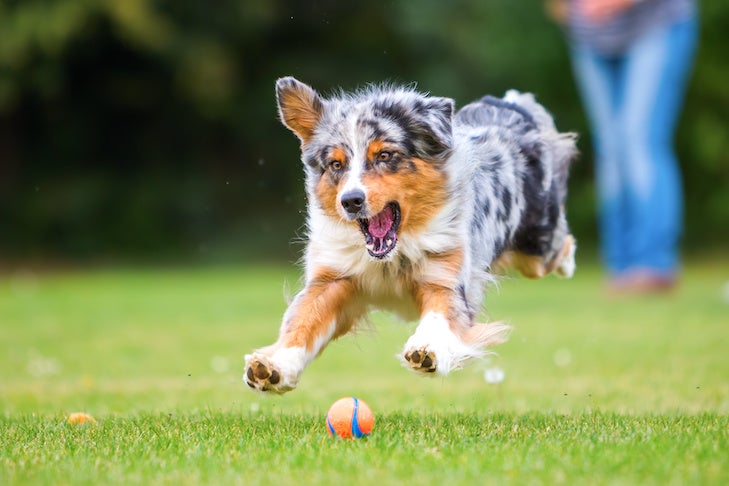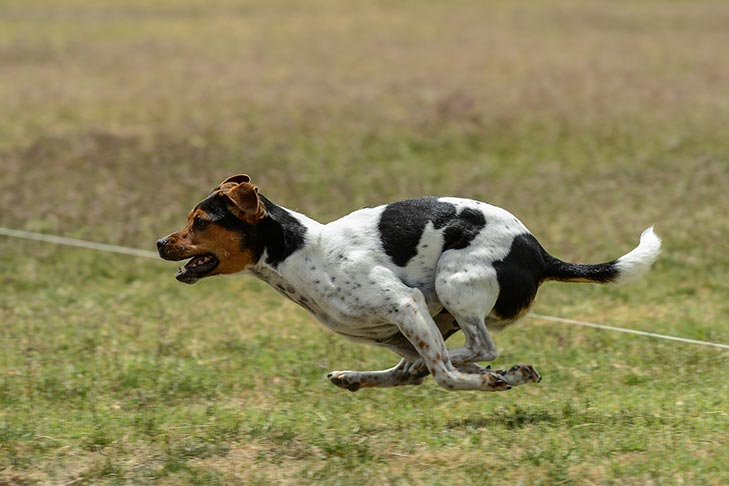
AKC is a participant in affiliate advertising programs designed to provide a means for sites to earn advertising fees by advertising and linking to akc.org. If you purchase a product through this article, we may receive a portion of the sale.
If you own a dog, you have probably found yourself wondering how much exercise a dog needs daily. Depending on your schedule, that question might sometimes sound more like “How much exercise does a dog really need every day?”
As with people, the answer varies from dog to dog and is dependent on age, health, and breed. There are a few standard guidelines you can follow, however, to make sure that your dog is getting all the exercise they need.
How Much Daily Exercise Does a Puppy Need?
Keep in mind a breed’s exercise requirements when choosing a puppy. It is not a good idea to buy an active dog breed unless you already lead an active lifestyle, and it is unrealistic to expect your Toy Poodle to join you for marathon training — unless you are pushing them in a stroller.
You might have noticed that your puppy gets a case of the “zoomies” several times a day. The zoomies are easily identified, and symptoms include madly racing around the house, sometimes at night, followed by collapsing into a puppy pile, preferably in your lap.

Puppies generally have more energy than adult dogs and so require more exercise in short bursts — like the zoomies. Since puppies are constantly growing, including several short walks or play sessions throughout the day is a safer choice than going for one really long walk, as this can be too hard on your puppy’s developing body. Ultimately, every puppy is different, and the more time you spend with your pet, the more you will learn about how much exercise and mental stimulation they need to keep them happy — and you sane!
Talk to your vet or breeder about how much daily activity is appropriate for your puppy, and don’t forget that exercise is a great way to train and socialize your new dog.
How Much Exercise Does an Adult Dog Need?
Your dog’s breed heavily influences the level of physical activity they need. High-energy breeds require a lot more exercise than lower-energy breeds.
Your dog’s health is also important. If your adult dog has a medical condition, such as hip dysplasia or heart or respiratory issues, talk with your vet about an appropriate exercise routine that will help them stay healthy without causing discomfort.
How Much Exercise Does a Senior Dog Need?
Your senior dog might not be able to run as far as they once did, and you might have to eventually restrict their run to a walk. But proper exercise is just as important for your senior dog as it is for your puppy.

Talk with your vet about exercising your senior dog, and also observe their behavior. As the owner, you know your dog best and are the best judge of how much exercise your dog can comfortably handle. Exercise provides all dogs with mental stimulation and keeps them active, which can help prolong their lives and reduce the risk of obesity.
Tips on Dog Exercise
“How much exercise does a dog need every day?” is often the first question owners ask. The second (and one frequently asked by owners of high-energy breeds) is “How do you exercise a dog?”
Taking your dog for a walk around the block is a great start, and it might be enough for breeds with lower exercise requirements. Every dog will appreciate variety every once in a while, however, and there are countless opportunities to exercise your dog in your daily life.
- Hiking: Dogs love the great outdoors just as much as you do. Take your dog along on your next hiking adventure or explore some new parks and trails in your area.
- Going With You When You Cycle: While biking with dogs isn’t appropriate for all canines, many dogs go with their owners when they ride. Cycling on the road is often dangerous, but many towns have bike paths where your dog can safely accompany you.
- Joining Skaters: Whether you inline skate, Rollerblade, or skateboard, your dog can accompany you. Just be sure to skate in an enclosed area at first while training your dog for this new activity, and always wear appropriate safety gear.
- Swimming: Many dogs love the water, and swimming is great for dogs with joint problems, as it provides low-impact exercise. A life jacket can help your dog stay in the water longer for an optimum cardio workout.
- Fetch: Fetch doesn’t have to be boring. Shake up your dog’s fetch routine by making them run uphill to retrieve a ball, or by tossing a floating toy into the water. Alternate between balls, flying discs, or other prized toys to keep your dog on their toes.
- Draft Work: Dogsledding isn’t just for sled dog breeds. Larger breeds often enjoy draft work, whether it involves a sled, a cart, or skijoring, and these activities are also fun for people.
- Obedience: Obedience work might not seem like exercise at first glance, but practicing recall, retrieving, and reinforcing basic commands offers mental stimulation, as well as exercise. You can also teach your dog fun new tricks like weaving and spinning.
- Dog Sports: With so many dog sports to choose from, you and your dog can try a variety of activities or stick with your favorites. AKC Lure Coursing, AKC Scent Work, AKC Agility, AKC Obedience, AKC Flyball, and AKC Rally are just a few of the options available.

Indoor Dog Exercises
Inclement weather can throw a wrench in your dog’s exercise routine. Hot days, cold days, and rainy days make it difficult to get outside for long periods of time, and may even pose health risks. Here are some indoor dog exercises you and your pup can do to burn off steam and stay in shape.
- Stairs: Running up and down the stairs a few times when you can’t get outside is great for building muscle. Just be sure not to push your dog too hard, as this exercise is just as strenuous for dogs as it is for people. Take special care with dog breeds that have long backs and shorter legs, as stairs may prove more challenging.
- Hide-and-Seek: Indoor games like hide-and-seek get your dog moving and provide mental stimulation. You can also work in a game of chase.
- Treadmill: If you’re looking for a great dog exercise for high-energy breeds, look no further than a treadmill designed for dogs. With careful training, your dog may grow to love treadmill workouts. While they are not a replacement for a walk or a run outside, treadmills build endurance and don’t rely on decent weather.
- Tug: Games of tug, when played properly, build muscle and the human-animal bond. Most dogs enjoy tug, and there are a wide variety of tug toys available.
- Agility: When we think of agility, we usually think of outdoor courses or large indoor spaces. However, you can practice agility at home. You even make your own course, using equipment made for the sport or using household supplies, such as broom handles, boxes, and ottomans. Alternatively, consider joining a local club with an indoor agility space.
Are you looking to improve your overall health and fitness, as well as your dog’s? Start working towards your AKC FIT DOG title!
Designed to improve the health of both dogs and owners, AKC FIT DOG is the perfect opportunity for you to work towards fitness goals while participating in fun activities, like swimming, hiking, and community runs. Start getting FIT with your dog today.

